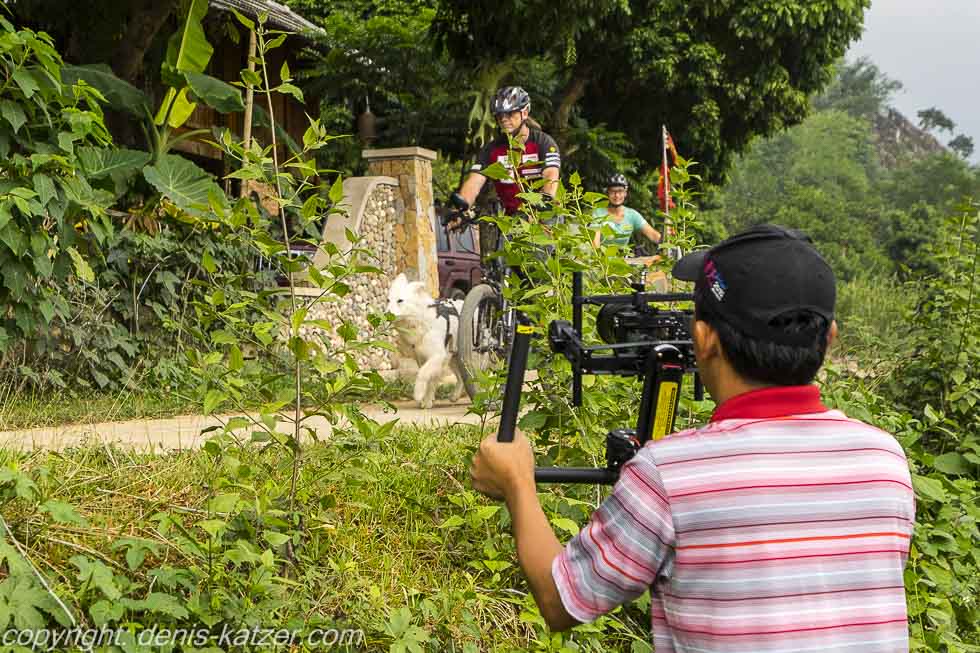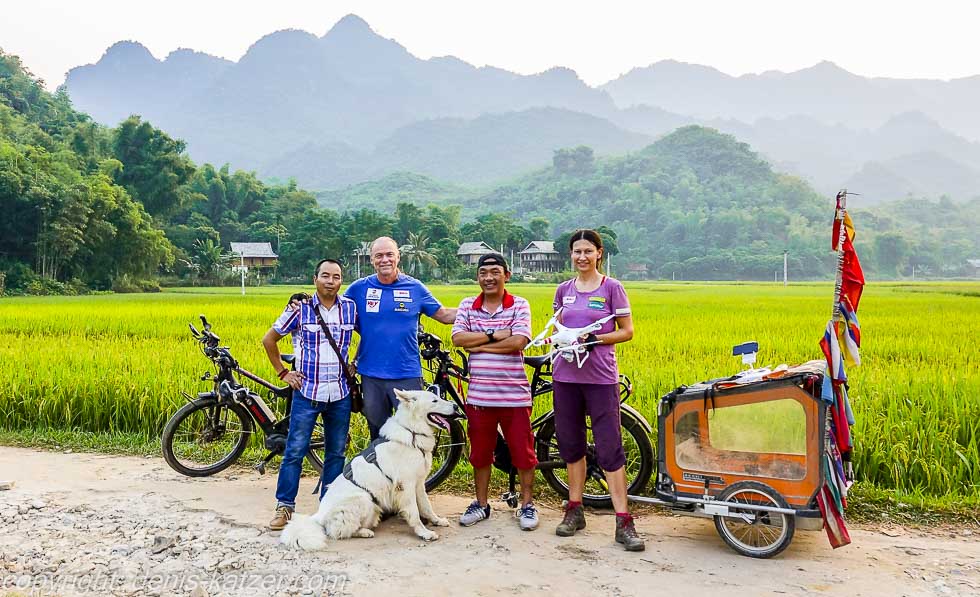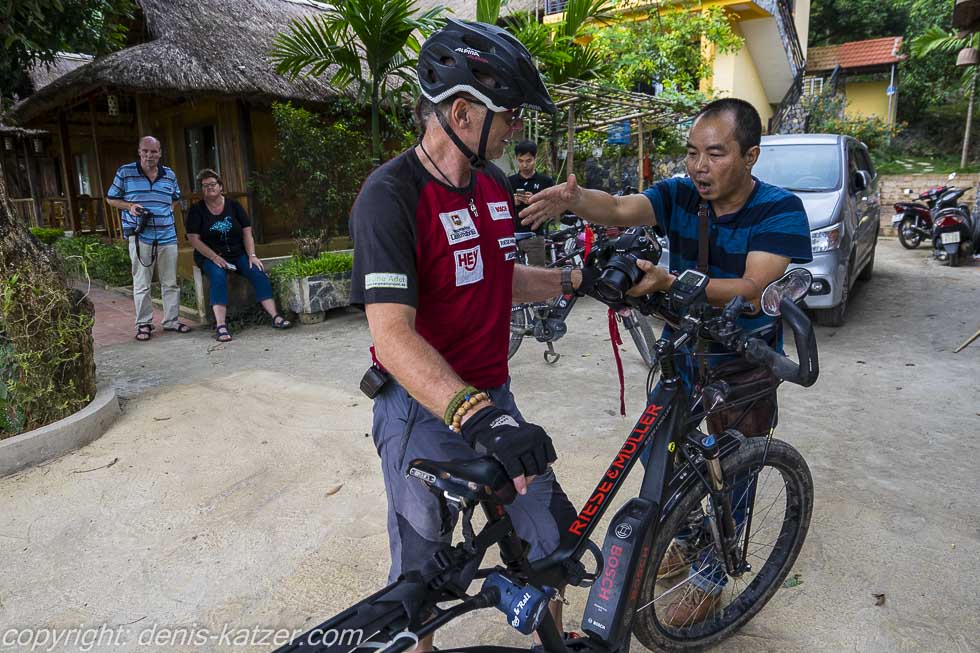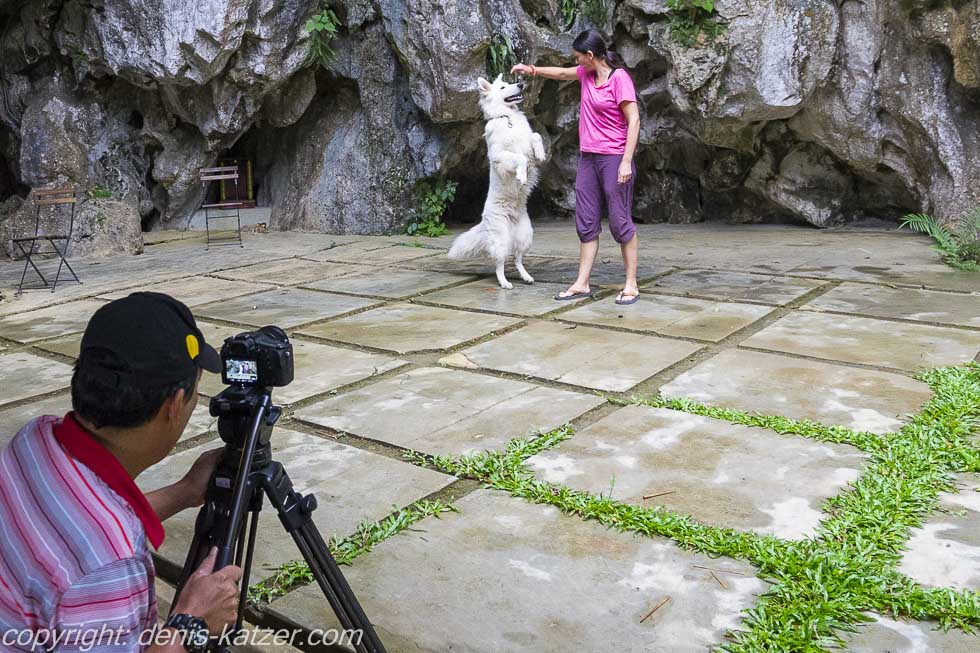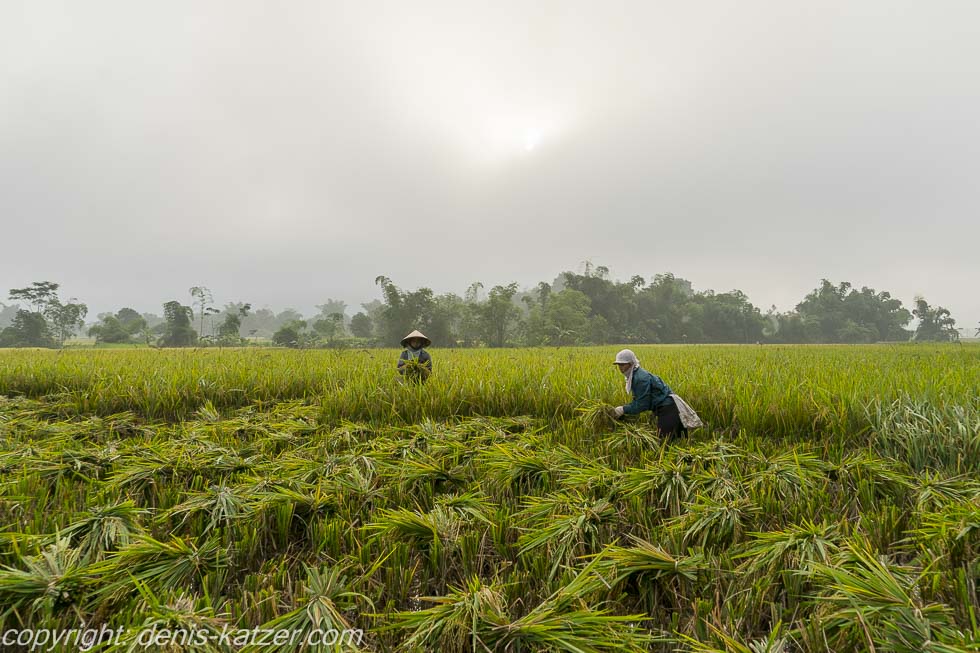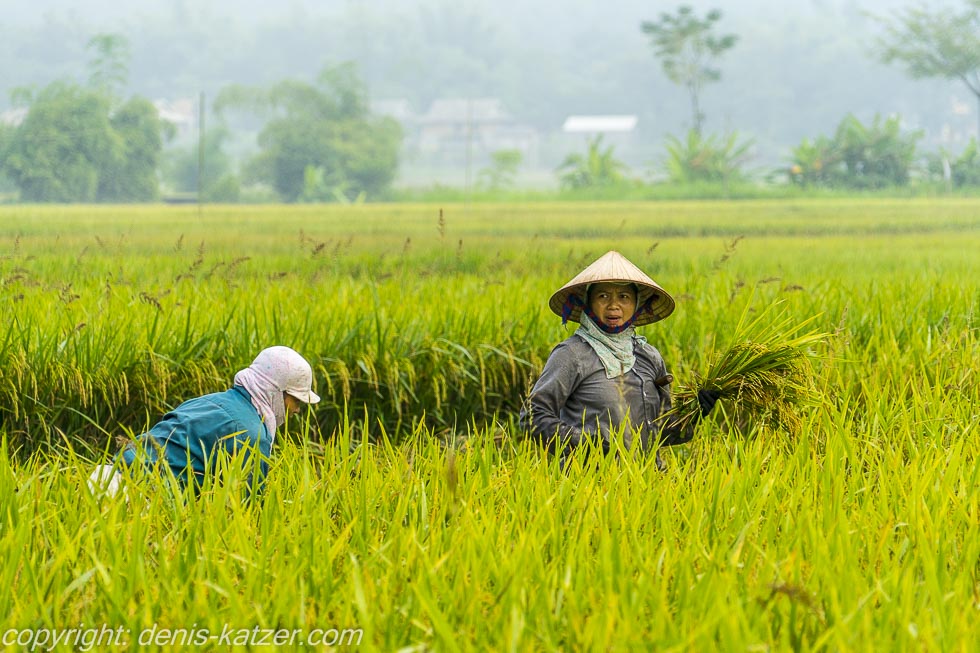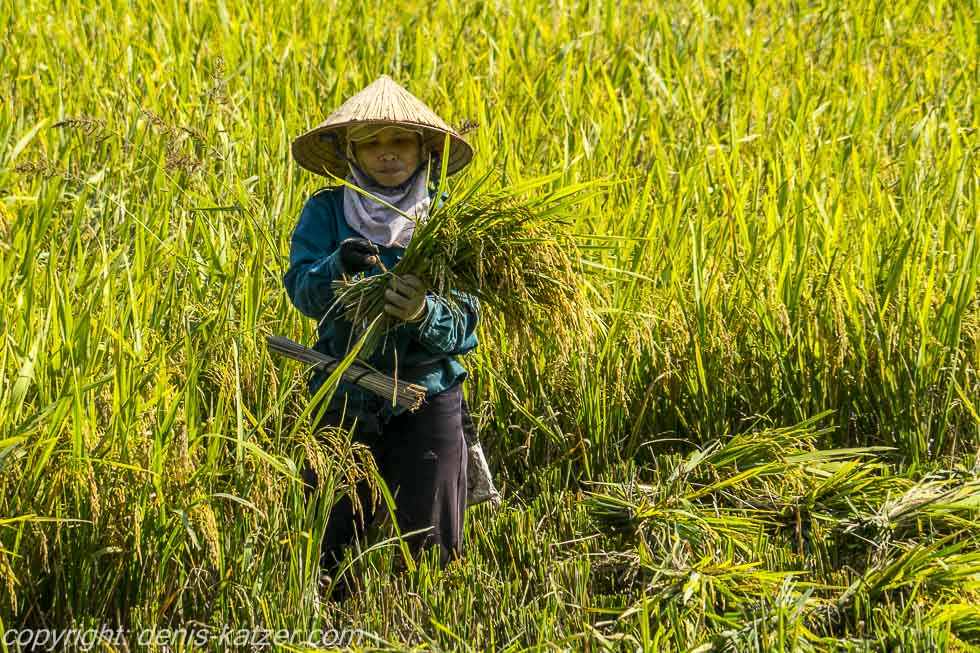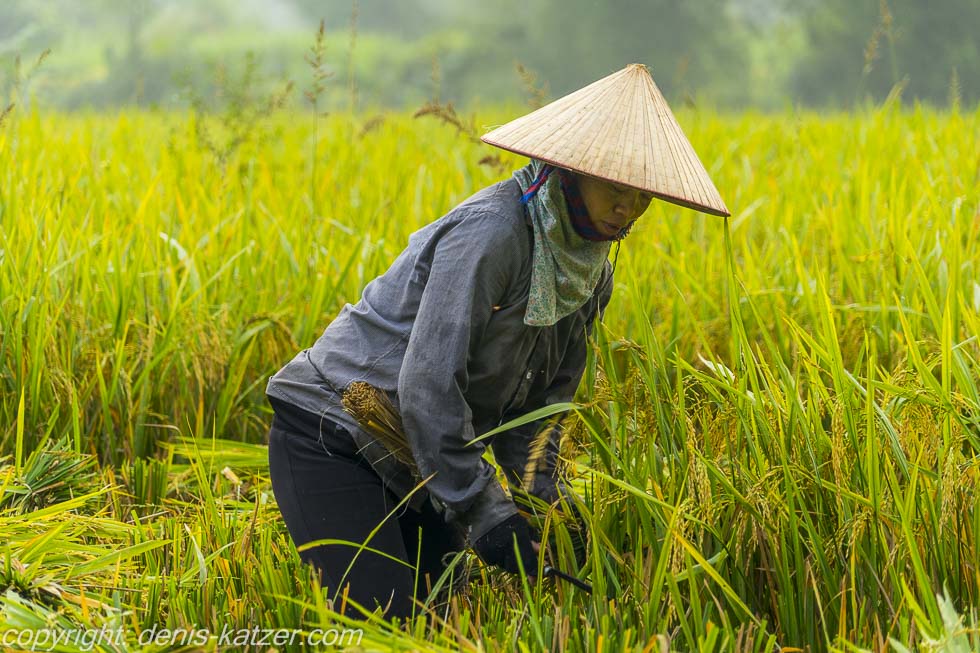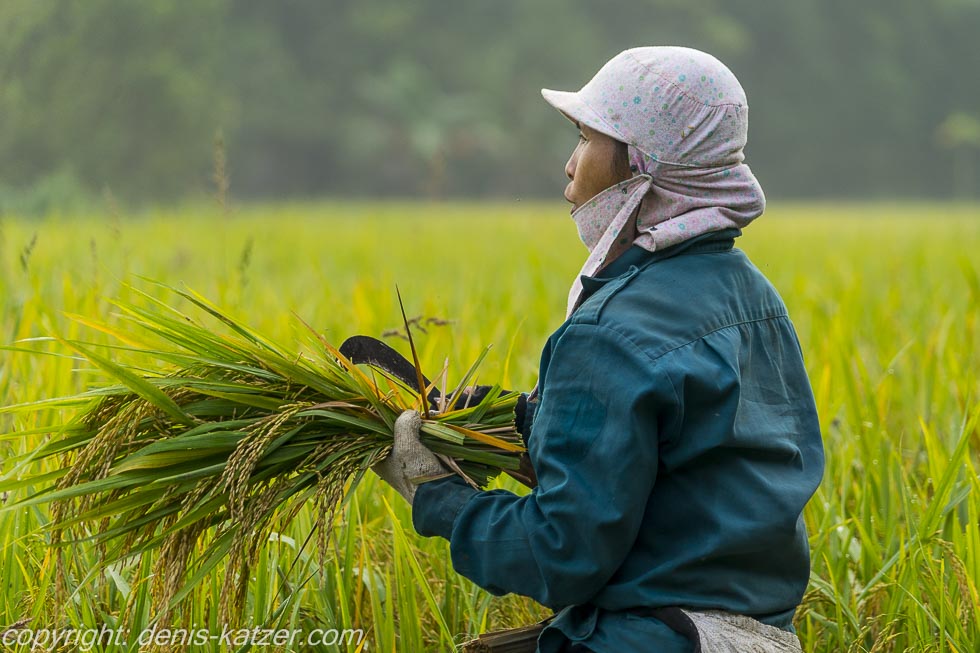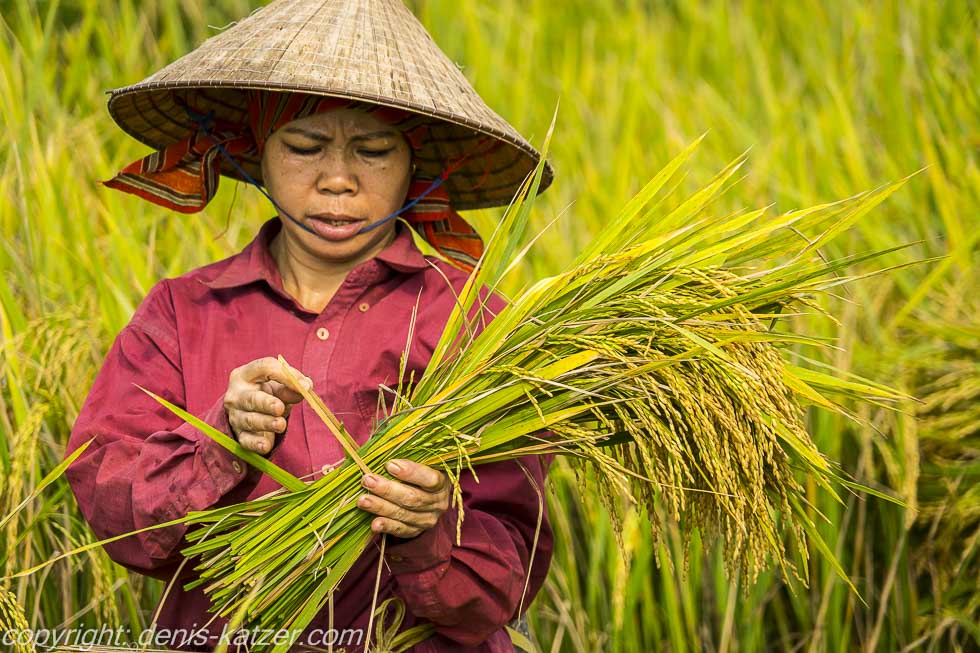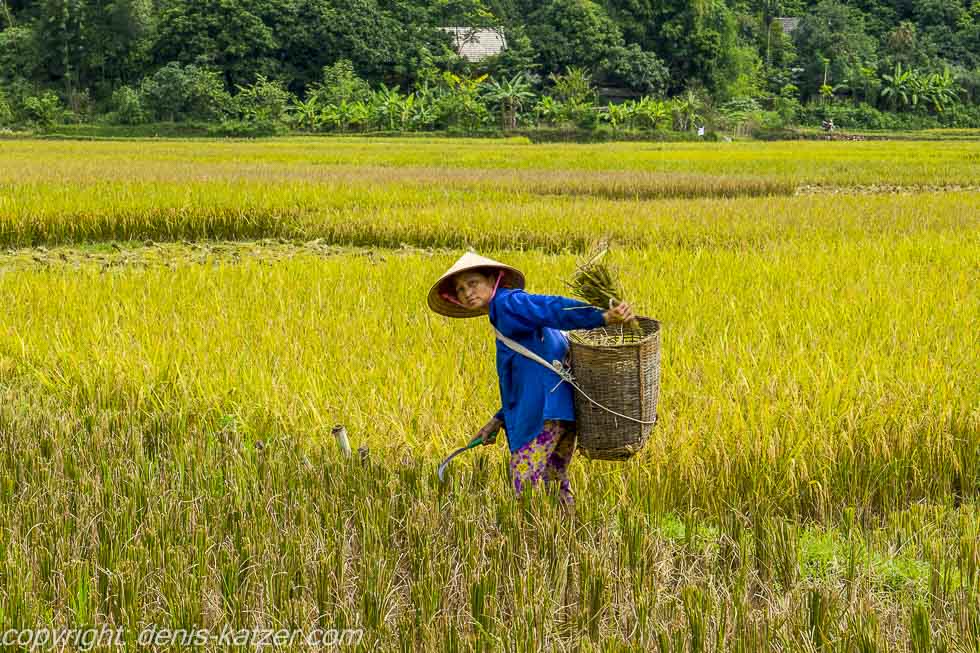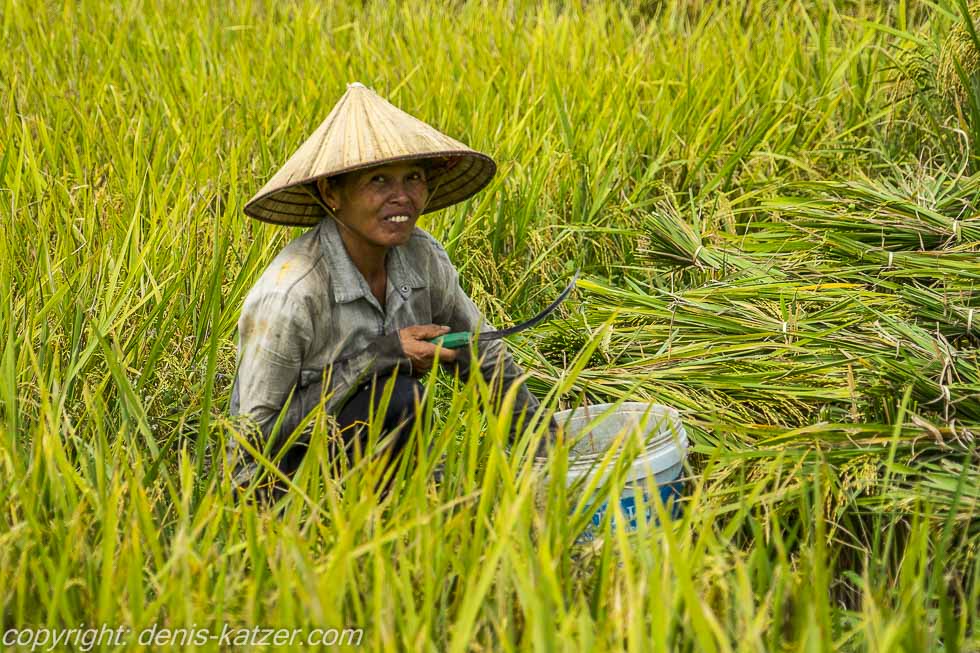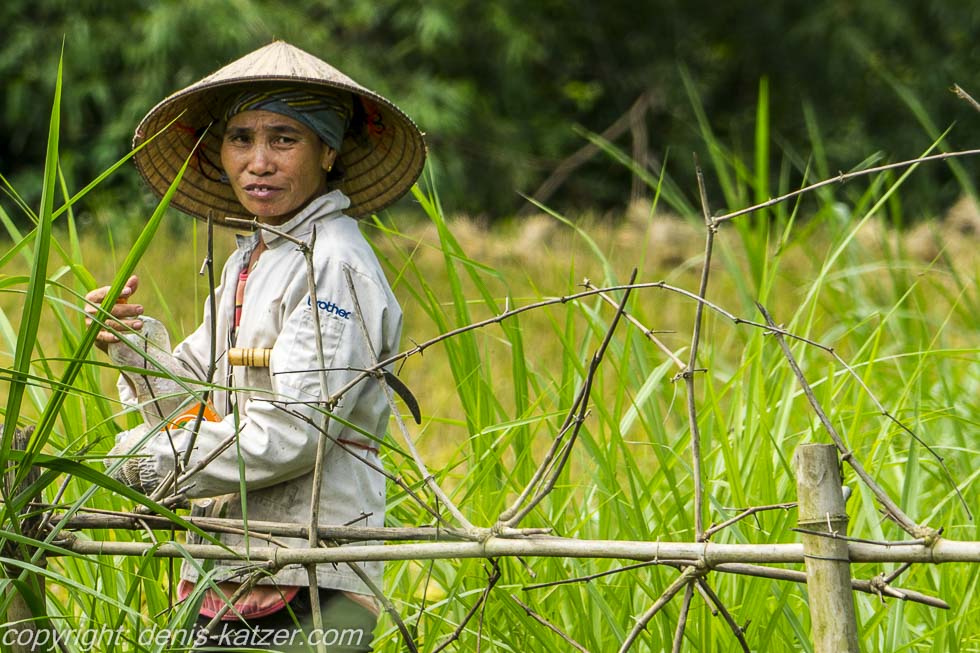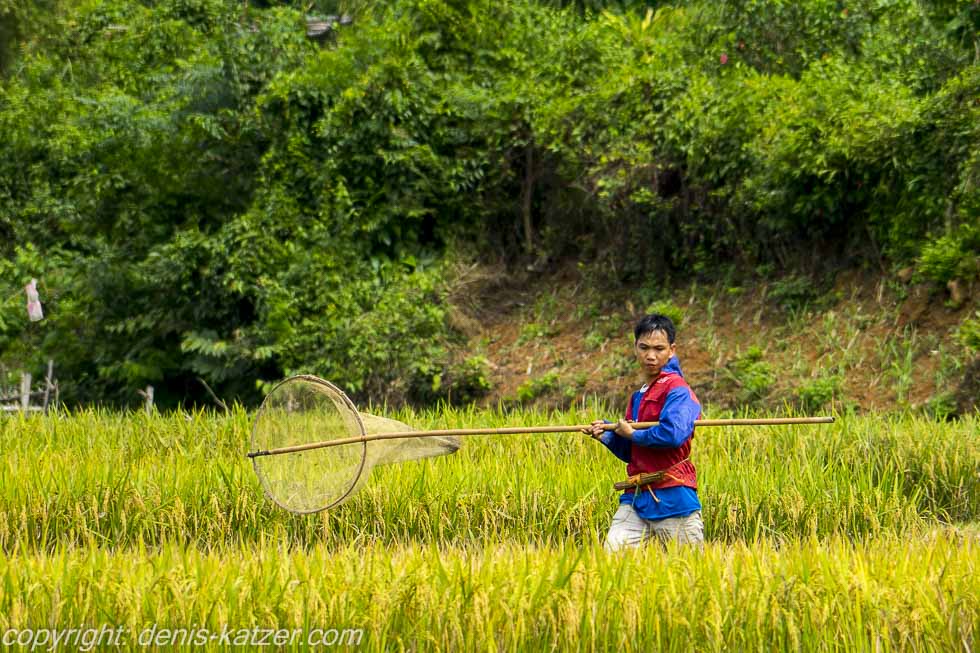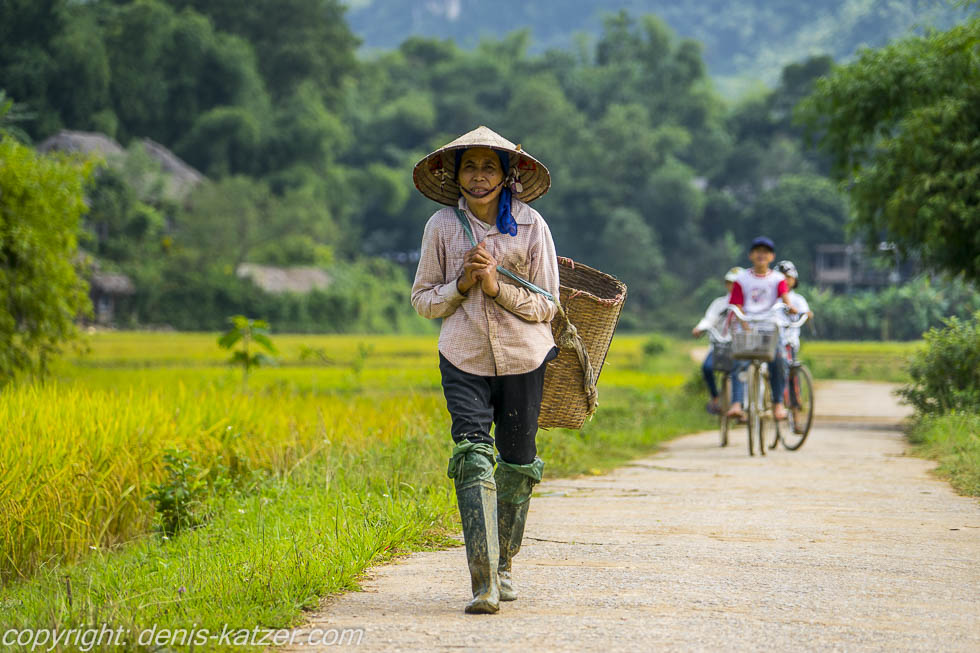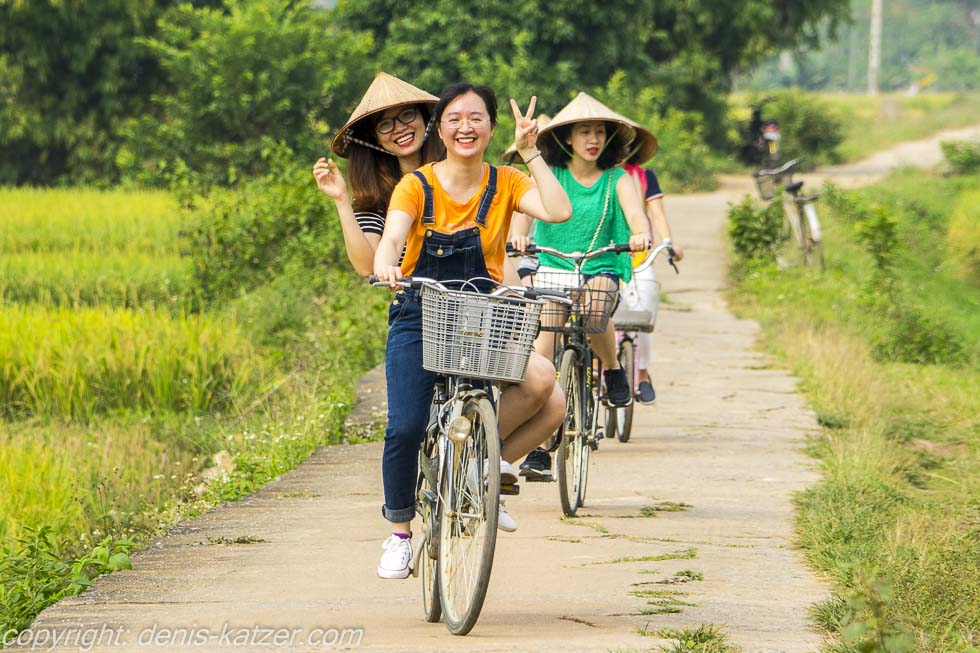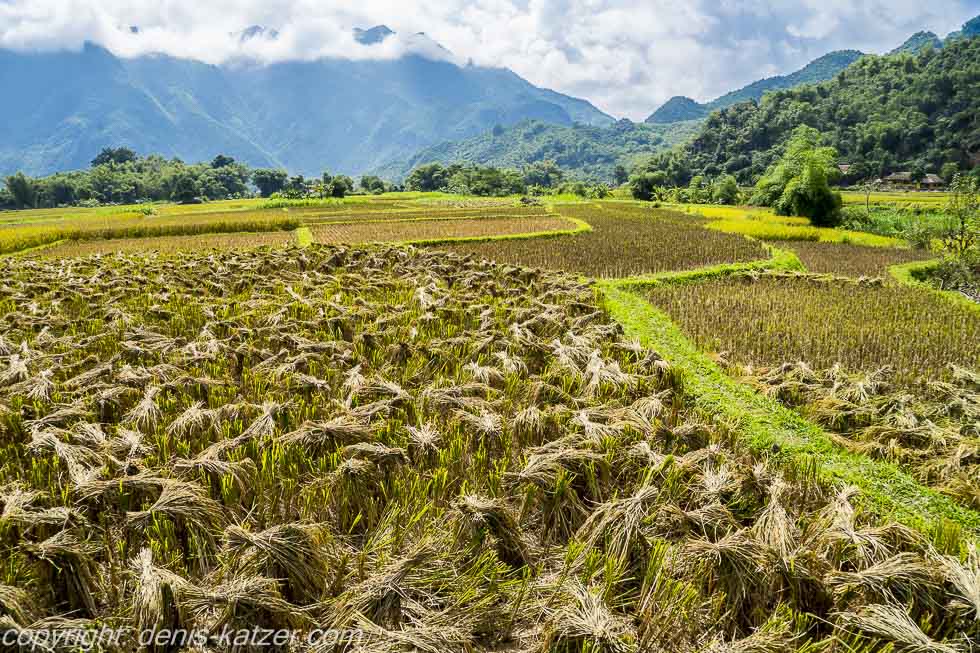
Drone flight and border crossing
N 20°40'14.6'' E 105°04'01.5''
Date:
12.10.2016 until 20.10.2016
Day: 474 – 482
Country:
Vietnam
Province:
Hòa Bình
Location:
May Chau
Latitude N:
20°40’14.6”
Longitude E:
105°04’01.5”
Daily kilometers:
Covered 290 km by car
Total kilometers:
20,012 km
Soil condition:
Asphalt / gravel
Total altitude meters:
54.661 m
Sunrise:
05:53 h – 05:56 h
Sunset:
5:39 pm – 5:32 pm
Temperature day max:
30°C
Temperature day min:
20°C
(Photos of the diary entry can be found at the end of the text).
Back in Mai Chau after the eventful trip to the Otherworld and Hanoi, Hung visits us with a small team to shoot another film. We agree to do it, even though it will again take up one or two days of our time. “I’ll give you the pipe material. You can then use it for your own purposes,” he offers. As Hung’s script dictates, we cycle along the narrow paths through the rice fields while cameraman Tho’s drone follows us. When we arrived here 2 ½ months ago, the small rice plants were being planted and today some farmers are starting to harvest them. That’s why the fields around us are bustling with activity. “Again!” shouts Hung, whereupon we cycle off again towards the setting sun. Tho, meanwhile, swears because his drone won’t take off. “Why should the Vietnamese be any different to us with technology?” I say. “It’s gone now,” says Tanja, pointing to the golden glow of the sunball peeking out from behind the mountains. “And the drone is still having trouble taking off,” I reply. “We should try again tomorrow,” Hung gives up. The next day, the sky is cloudy. Hung changes his plans, so his cameraman films Tanja training her dog, us doing yoga, having breakfast and going for a walk. Towards late afternoon, heavy monsoon rain puts an end to the filming.
Two days later, it is still pouring with rain. Manh Do offers to drive us to the Laotian border for a special price of US$ 80. As the journey with a local bus can take two days due to a lack of connections, and we may have difficulties taking Ajaci on the bus, we are pleased with Manh Dos’ offer.
Manh Do races along the gravel road as if he wanted to win a rally. His off-roader darts through deep puddles, curves around herds of buffalo, past rocks falling from the mountains and boulders lying on the road. We cross simple villages, chasing away cows, goats and dogs. It’s two hours up and down the mountains on endless serpentines until I feel sick again. “Here we are,” he laughs as we arrive at the lonely border in the pouring rain. “I’ll wait for you here with Ajaci and eat something over there in the street restaurant in the meantime. Good luck.” “See you soon,” we say goodbye.
“Xin chào” (hello) is how we greet the Vietnamese border officials and explain that we are only going to walk to Laos for a short time before coming back. “Well, first you have to apply for a new Vietnam visa in Vientiane (the capital of Laos).” “We already have”, I say, whereupon the man frantically flicks through my passport to find it. “The new visa is in our second passport,” I explain and hand it to him. “Two passports?” he asks, puzzled, checking the new visa. “Right, I’ll see you soon then,” he says, scratching his head and stamping the exit stamp into the document. Just a few hundred meters further on we reach the Laotian border. We are the only border crossers at this time. An official checks our passport and discovers our old Laos visa, which we let expire due to my shoulder injury and the resulting long convalescence stay in Mai Chau. “You already have a visa. Then you don’t need to apply for a new one,” we are pleased to hear. The man disappears into a building with our passports, but reappears a few minutes later and says: “Your visas have expired, please fill out the application forms for a new visa.” It takes a while until we tell the gentlemen that we want to re-enter Vietnam as soon as we receive our Laos visas. Again there is confusion about our second passes. “They don’t seem to have experienced that here yet,” I say quietly. “Which passport should we stamp the entry visa in now?” “In the passport that also contains our old Vietnam visa,” we reply. “Are you sure about that? Have you clarified this with our colleagues in Vietnam?” “We have.” “Okay,” we hear his doubtful reply, then the officer disappears again with our passports. As the Laotian borders are known to be corrupt, I get cold feet. “I hope everything goes smoothly,” I whisper to Tanja. “Why not? There’s nothing wrong with our documents.” “Yes, it is. It’s just a question of whether the gentlemen see it the same way. Ultimately, we are completely at the mercy of these officials.” “Please sit down,” a man in uniform asks us to sit down on a shabby wooden bench. 15 minutes pass before the man reappears with our travel documents and asks us again to fill out the forms for the Laos visa. “What a mess, now I’ve made a mistake,” Tanja grumbles and takes a new piece of paper. We hand the completed, shabby-looking copies with our details to the officer. “US$ 80,” the man demands a while later. “80 US DOLLARS? That’s a lot,” I complain. “A visa costs US$ 40 per person,” the man justifies himself. As we don’t have any dollars, we ask if we can also pay in Vietnamese dong. A nod is the answer. “2.1 million dong please.” “That’s the equivalent of 90 US dollars,” I calculate. “We have to convert the dong back into our currency. In doing so, we include the loss,” is the explanation. As we have no other option, we grudgingly accept the obvious rip-off. “Oh yes. For the second form they destroyed, we get another dollar.” “Not a chance!” Tanja and I say resolutely, ready to fight, because this impudent guy has now crossed the line with this demand. The face under the service cap looks at us, thinks for a while, and obviously comes to the conclusion that he doesn’t want to cause trouble over a dollar. With the valid Laos visa in our old passport, we now cross a street and have another official give us an exit stamp. “Good bye,” we say goodbye. “Good bye,” we hear the officers say. Then we walk back to Vietnam. Because the whole procedure took an hour, it is now 12:00 noon. “Lunch break,” says a Vietnamese official closing his door. “When are they coming back?” I ask. He shows me his watch and points to the two. At 2 p.m. on the dot, after the end of the afternoon nap, the officers appear again. We hand over our new passports with the new Vietnam visa. “Where’s the entry stamp?” asks the man. In the old passport,” we say and hand over this document too. “You should have had the entry stamp in your passport, which also contains your new Vietnam visa,” we are puzzled by his statement, which contradicts what he explained three hours ago. “That’s all absolutely fine. The exit and entry process is in the passport that contains the visas. That’s all correct. That’s how all border officials around the world do it,” Tanja explains to the man in uniform. Scrutinizing eyes look at her. The corresponding face seems to be thinking. Tock. The stamp hammers on the new Vietnam visa. When we are back in the car with Manh Do, he says: “Our officials are also extremely corrupt. He only wanted to be bribed by you and obviously didn’t pursue his desire further because of the language difficulties…
If you would like to find out more about our adventures, you can find our books under this link.
The live coverage is supported by the companies Gesat GmbH: www.gesat.com and roda computer GmbH http://roda-computer.com/ The satellite telephone Explorer 300 from Gesat and the rugged notebook Pegasus RP9 from Roda are the pillars of the transmission. Pegasus RP9 from Roda are the pillars of the transmission.
